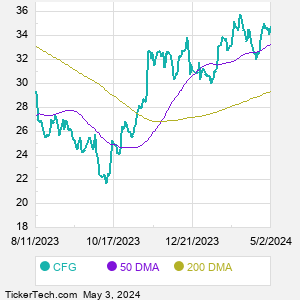Citizens Financial Group is a bank holding company and a financial holding company. Through its banking subsidiary, Citizens Bank, National Association, Co. manages its business through two business segments: Consumer Banking, which provides deposit products, mortgage and home equity lending, credit cards, business loans, wealth management and investment services; and Commercial Banking, which provides lending and leasing, deposit and treasury management services, foreign exchange, interest rate and commodity risk management solutions, as well as syndicated loans, corporate finance, mergers and acquisitions, and debt and equity capital markets capabilities.
When researching a stock like Citizens Financial Group, many investors are the most familiar with Fundamental Analysis — looking at a company's balance sheet, earnings, revenues, and what's happening in that company's underlying business. Investors who use Fundamental Analysis to identify good stocks to buy or sell can also benefit from CFG Technical Analysis to help find a good entry or exit point. Technical Analysis is blind to the fundamentals and looks only at the trading data for CFG stock — the real life supply and demand for the stock over time — and examines that data in different ways. One of these ways is called the Relative Strength Index, or RSI. This popular indicator, originally developed in the 1970's by J. Welles Wilder, looks at a 14-day moving average of a stock's gains on its up days, versus its losses on its down days. The resulting CFG RSI is a value that measures momentum, oscillating between "oversold" and "overbought" on a scale of zero to 100. A reading below 30 is viewed to be oversold, which a bullish investor could look to as a sign that the selling is in the process of exhausting itself, and look for entry point opportunities. A reading above 70 is viewed to be overbought, which could indicate that a rally in progress is starting to get crowded with buyers. If the rally has been a long one, that could be a sign that a pullback is overdue. |



